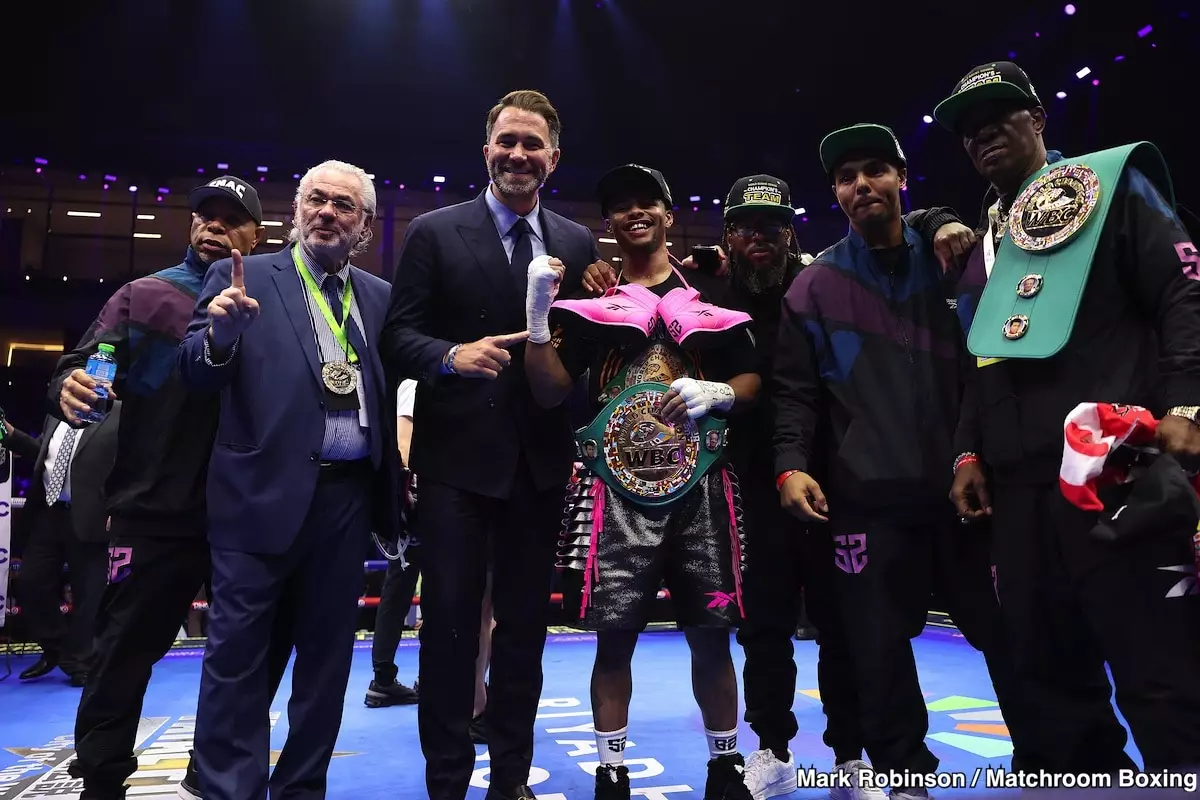As Shakur Stevenson approaches his highly anticipated fight against William Zepeda, the dynamics between promoters, contracts, and fighter ambitions come into sharper focus. Stevenson, revered for his tactical prowess and undefeated record, finds himself at a crossroads, caught in the oscillating world of boxing promotion. Promoter Eddie Hearn’s comments underscore the precarious nature of Stevenson’s current contract situation with Matchroom, pointing to both the promise and peril of his next bout.
Hearn reveals in his dealings with Lou DiBella—another heavyweight in the boxing promotion arena—an undercurrent of tension surrounding Stevenson’s two-fight contract. The dynamics appear to sway with Stevenson’s performance: a stellar outing against Zepeda could elevate him to greater heights, attracting interest from multiple promoters, while a subpar performance could seal his fate at Matchroom. This duality not only reflects the harsh realities of professional boxing but also emphasizes the importance of effective management and promotion amidst competition.
The Unveiling of Promoter Relations
As Hearn prepares to meet with Stevenson and his team, including Saudi Arabian heavyweight Turki Alalshikh, the confluence of interests becomes evident. Hearn’s desire to retain Stevenson shines through his strategic approach; he recognizes that a champion’s value can fluctuate drastically based on performance. The looming question remains: will Stevenson remain a cornerstone of Matchroom’s future plans, or will he veer off in pursuit of new promotional opportunities?
Moreover, the notion that Stevenson might consider leaving Matchroom does not stem solely from contractual constraints but also speaks volumes about the support system surrounding a fighter. In boxing, the promoter-fighter relationship often determines not only the trajectory of a fighter’s career but also their mental and emotional well-being. Hearn’s acknowledgment of online criticism and the toll it takes on fighters like Stevenson invites a conversation about the burdens of public scrutiny in this hyper-competitive industry.
Analyzing the Fight’s Implications
The fight against Zepeda on July 12th is pivotal for Stevenson, given the stakes at play. Zepeda, with an impressive undefeated record, poses a formidable challenge—one that could either solidify Stevenson’s position or lead to potential downfall. Should Stevenson replicate previous performances characterized by caution rather than aggression, questions surrounding his capabilities at lightweight will proliferate.
The potential for a loss raises a valuable discussion about the matchmaking strategy employed by promoters. Hearn amusingly hints at the need for “soft matchmaking,” a strategy frequently used to protect fighters suffering from vulnerabilities—in this case, Stevenson’s suggested fragility at 135 pounds due to hand issues. This approach raises ethical questions in boxing: is it truly fostering talent, or is it merely staving off defeat for the immediate financial benefit of promoters?
Examining Fighter Agency in Promotions
In the conversation surrounding Stevenson’s future, the larger narrative involves the autonomy fighters possess in navigating their careers. The battle between financial security and seeking competitive challenges often leads to difficult decisions. Fighters like Stevenson must carefully assess their worth within a promotional landscape where contracts can either empower or constrain.
Hearn’s attempt to underscored the supportive relationship demonstrates an understanding of the multifaceted nature of promotion. Yet, the reality remains that the boxing industry is fraught with unpredictable rates of success and failure, often teetering on the edge of speculation and rumor. The balance of power is in continuous flux, and fighters must evolve, adapting to new circumstances and opportunities.
The Role of Media in Shaping Perceptions
Media narratives play a pivotal role in shaping public perception and, consequently, a fighter’s mental resilience. Hearn alludes to the damaging effects of social media hostility on fighters, particularly following performance setbacks. The way stories are framed—be it in promotion or criticism—greatly influences a fighter’s mental space heading into a key match.
This harsh scrutiny outlines the need for a robust support network for athletes. With high stakes attached to public image and financial contracts, the complexities of care and attention to mental fortitude in athletes cannot be overlooked. A fighter’s journey is not solely about their physical training but also their capacity to persevere against the psychological battles enforced by both audience and industry alike.
Shakur Stevenson stands upon a precipice, and his actions in the ring and decisions off are set to reverberate through the boxing world. The complex interplay between promotion, athlete agency, and external pressures defines this pivotal moment in his career—a narrative that reflects the broader challenges inherent in the boxing industry today.

